Contemporary Tourism Issues in Great Barrier Reef
VerifiedAdded on 2023/04/22
|15
|3838
|157
AI Summary
The report aims at understanding the different contemporary tourism issues in Great Barrier Reef and the different activities that are undertaken by the concerned organization in upholding the efficiency of the sustainable tourism.
Contribute Materials
Your contribution can guide someone’s learning journey. Share your
documents today.
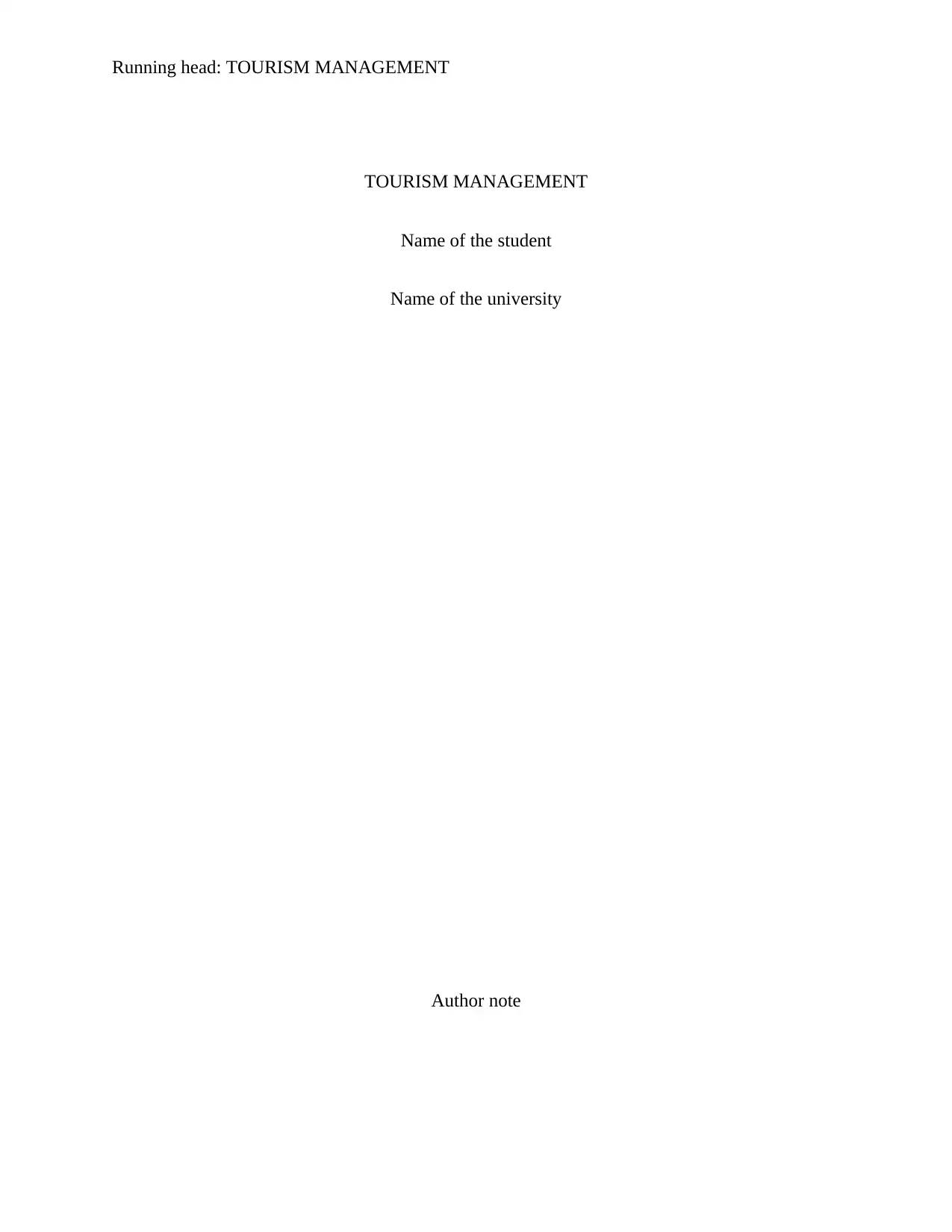
Running head: TOURISM MANAGEMENT
TOURISM MANAGEMENT
Name of the student
Name of the university
Author note
TOURISM MANAGEMENT
Name of the student
Name of the university
Author note
Secure Best Marks with AI Grader
Need help grading? Try our AI Grader for instant feedback on your assignments.

1TOURISM MANAGEMENT
Executive summary
The report aims at understanding the different contemporary tourism issues in Great Barrier Reef
and the different activities that are undertaken by the concerned organization in upholding the
efficiency of the sustainable tourism. The report will enumerate the factors and critically assess
the issues that are encountered by tourism in the context of the Great Barrier Reef.
Executive summary
The report aims at understanding the different contemporary tourism issues in Great Barrier Reef
and the different activities that are undertaken by the concerned organization in upholding the
efficiency of the sustainable tourism. The report will enumerate the factors and critically assess
the issues that are encountered by tourism in the context of the Great Barrier Reef.
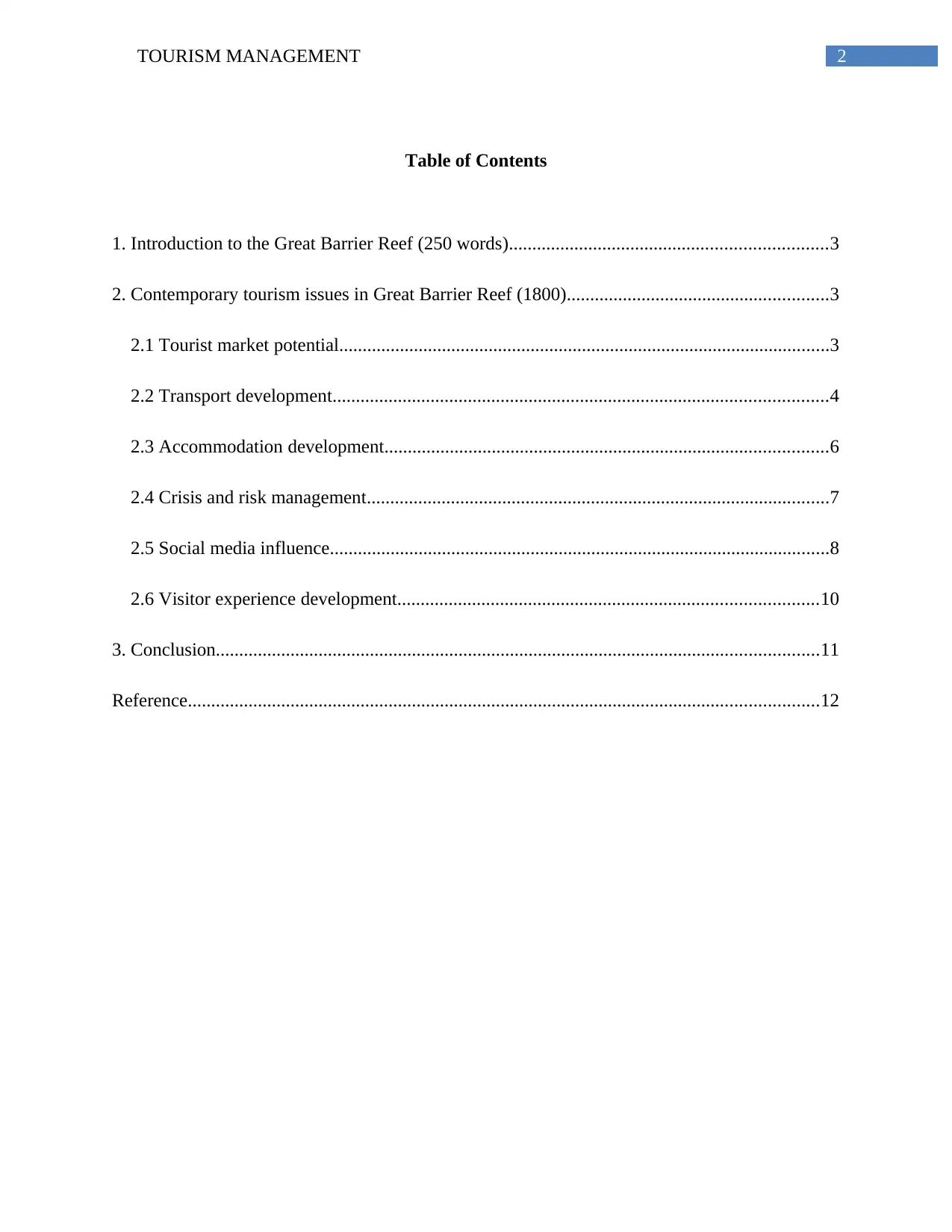
2TOURISM MANAGEMENT
Table of Contents
1. Introduction to the Great Barrier Reef (250 words)....................................................................3
2. Contemporary tourism issues in Great Barrier Reef (1800)........................................................3
2.1 Tourist market potential.........................................................................................................3
2.2 Transport development..........................................................................................................4
2.3 Accommodation development...............................................................................................6
2.4 Crisis and risk management...................................................................................................7
2.5 Social media influence...........................................................................................................8
2.6 Visitor experience development..........................................................................................10
3. Conclusion.................................................................................................................................11
Reference.......................................................................................................................................12
Table of Contents
1. Introduction to the Great Barrier Reef (250 words)....................................................................3
2. Contemporary tourism issues in Great Barrier Reef (1800)........................................................3
2.1 Tourist market potential.........................................................................................................3
2.2 Transport development..........................................................................................................4
2.3 Accommodation development...............................................................................................6
2.4 Crisis and risk management...................................................................................................7
2.5 Social media influence...........................................................................................................8
2.6 Visitor experience development..........................................................................................10
3. Conclusion.................................................................................................................................11
Reference.......................................................................................................................................12
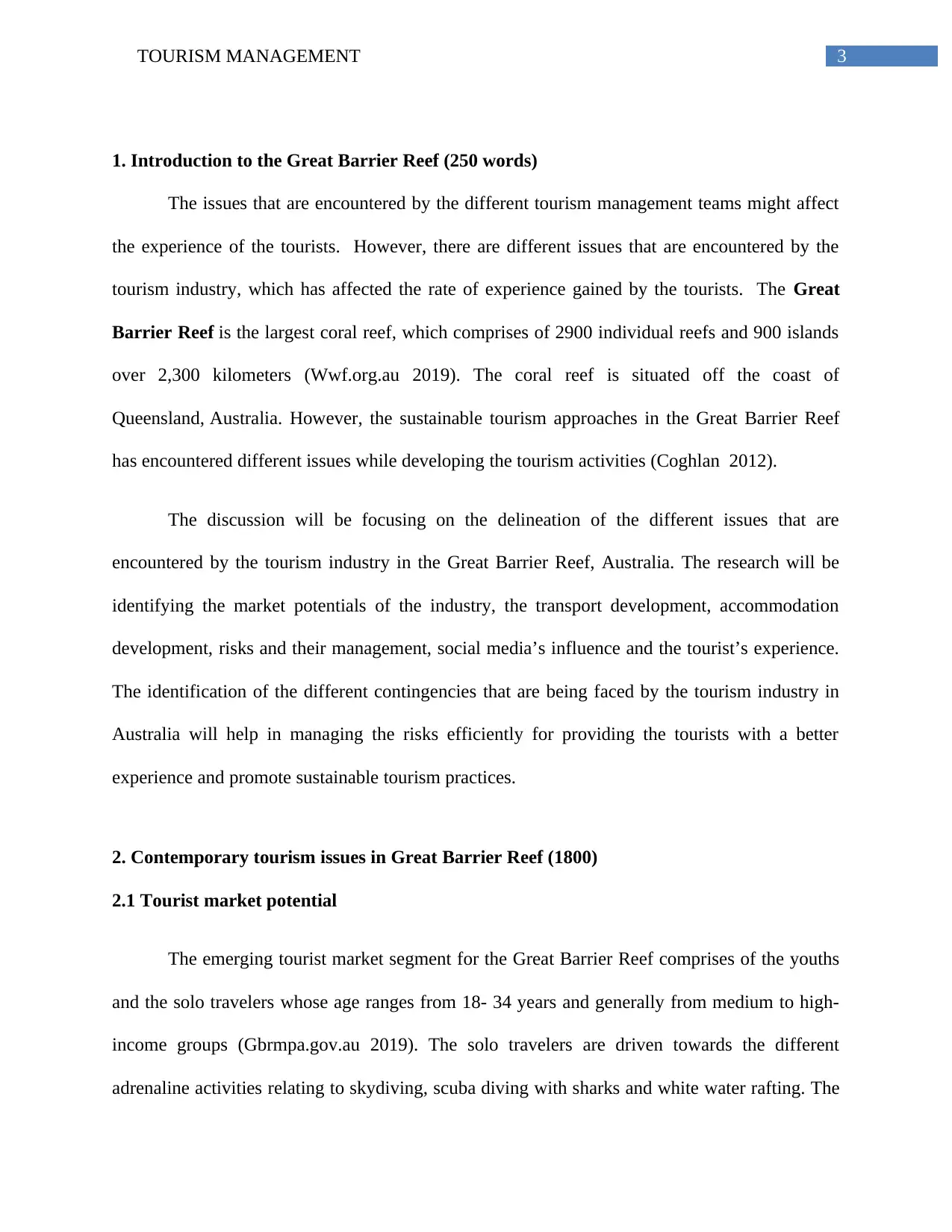
3TOURISM MANAGEMENT
1. Introduction to the Great Barrier Reef (250 words)
The issues that are encountered by the different tourism management teams might affect
the experience of the tourists. However, there are different issues that are encountered by the
tourism industry, which has affected the rate of experience gained by the tourists. The Great
Barrier Reef is the largest coral reef, which comprises of 2900 individual reefs and 900 islands
over 2,300 kilometers (Wwf.org.au 2019). The coral reef is situated off the coast of
Queensland, Australia. However, the sustainable tourism approaches in the Great Barrier Reef
has encountered different issues while developing the tourism activities (Coghlan 2012).
The discussion will be focusing on the delineation of the different issues that are
encountered by the tourism industry in the Great Barrier Reef, Australia. The research will be
identifying the market potentials of the industry, the transport development, accommodation
development, risks and their management, social media’s influence and the tourist’s experience.
The identification of the different contingencies that are being faced by the tourism industry in
Australia will help in managing the risks efficiently for providing the tourists with a better
experience and promote sustainable tourism practices.
2. Contemporary tourism issues in Great Barrier Reef (1800)
2.1 Tourist market potential
The emerging tourist market segment for the Great Barrier Reef comprises of the youths
and the solo travelers whose age ranges from 18- 34 years and generally from medium to high-
income groups (Gbrmpa.gov.au 2019). The solo travelers are driven towards the different
adrenaline activities relating to skydiving, scuba diving with sharks and white water rafting. The
1. Introduction to the Great Barrier Reef (250 words)
The issues that are encountered by the different tourism management teams might affect
the experience of the tourists. However, there are different issues that are encountered by the
tourism industry, which has affected the rate of experience gained by the tourists. The Great
Barrier Reef is the largest coral reef, which comprises of 2900 individual reefs and 900 islands
over 2,300 kilometers (Wwf.org.au 2019). The coral reef is situated off the coast of
Queensland, Australia. However, the sustainable tourism approaches in the Great Barrier Reef
has encountered different issues while developing the tourism activities (Coghlan 2012).
The discussion will be focusing on the delineation of the different issues that are
encountered by the tourism industry in the Great Barrier Reef, Australia. The research will be
identifying the market potentials of the industry, the transport development, accommodation
development, risks and their management, social media’s influence and the tourist’s experience.
The identification of the different contingencies that are being faced by the tourism industry in
Australia will help in managing the risks efficiently for providing the tourists with a better
experience and promote sustainable tourism practices.
2. Contemporary tourism issues in Great Barrier Reef (1800)
2.1 Tourist market potential
The emerging tourist market segment for the Great Barrier Reef comprises of the youths
and the solo travelers whose age ranges from 18- 34 years and generally from medium to high-
income groups (Gbrmpa.gov.au 2019). The solo travelers are driven towards the different
adrenaline activities relating to skydiving, scuba diving with sharks and white water rafting. The
Secure Best Marks with AI Grader
Need help grading? Try our AI Grader for instant feedback on your assignments.
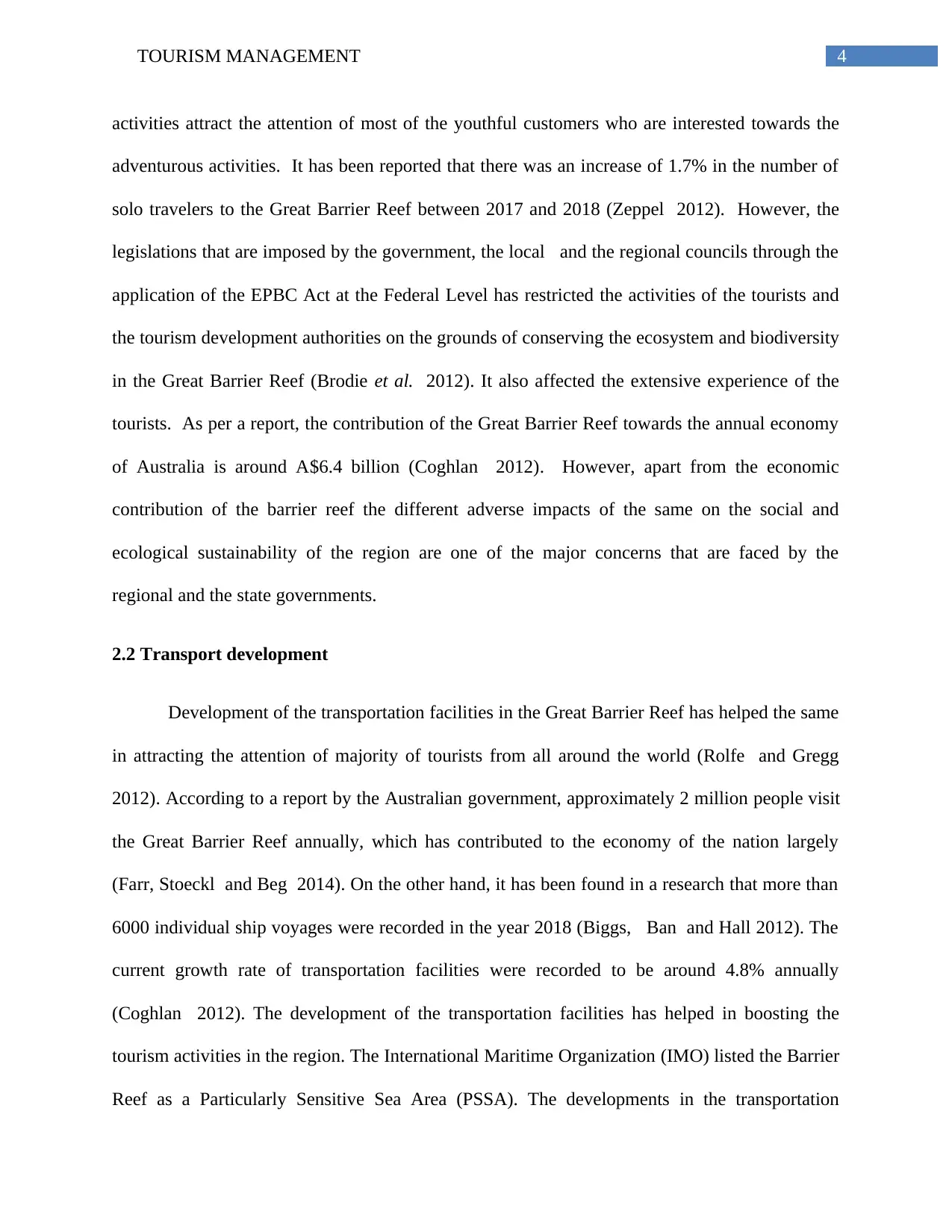
4TOURISM MANAGEMENT
activities attract the attention of most of the youthful customers who are interested towards the
adventurous activities. It has been reported that there was an increase of 1.7% in the number of
solo travelers to the Great Barrier Reef between 2017 and 2018 (Zeppel 2012). However, the
legislations that are imposed by the government, the local and the regional councils through the
application of the EPBC Act at the Federal Level has restricted the activities of the tourists and
the tourism development authorities on the grounds of conserving the ecosystem and biodiversity
in the Great Barrier Reef (Brodie et al. 2012). It also affected the extensive experience of the
tourists. As per a report, the contribution of the Great Barrier Reef towards the annual economy
of Australia is around A$6.4 billion (Coghlan 2012). However, apart from the economic
contribution of the barrier reef the different adverse impacts of the same on the social and
ecological sustainability of the region are one of the major concerns that are faced by the
regional and the state governments.
2.2 Transport development
Development of the transportation facilities in the Great Barrier Reef has helped the same
in attracting the attention of majority of tourists from all around the world (Rolfe and Gregg
2012). According to a report by the Australian government, approximately 2 million people visit
the Great Barrier Reef annually, which has contributed to the economy of the nation largely
(Farr, Stoeckl and Beg 2014). On the other hand, it has been found in a research that more than
6000 individual ship voyages were recorded in the year 2018 (Biggs, Ban and Hall 2012). The
current growth rate of transportation facilities were recorded to be around 4.8% annually
(Coghlan 2012). The development of the transportation facilities has helped in boosting the
tourism activities in the region. The International Maritime Organization (IMO) listed the Barrier
Reef as a Particularly Sensitive Sea Area (PSSA). The developments in the transportation
activities attract the attention of most of the youthful customers who are interested towards the
adventurous activities. It has been reported that there was an increase of 1.7% in the number of
solo travelers to the Great Barrier Reef between 2017 and 2018 (Zeppel 2012). However, the
legislations that are imposed by the government, the local and the regional councils through the
application of the EPBC Act at the Federal Level has restricted the activities of the tourists and
the tourism development authorities on the grounds of conserving the ecosystem and biodiversity
in the Great Barrier Reef (Brodie et al. 2012). It also affected the extensive experience of the
tourists. As per a report, the contribution of the Great Barrier Reef towards the annual economy
of Australia is around A$6.4 billion (Coghlan 2012). However, apart from the economic
contribution of the barrier reef the different adverse impacts of the same on the social and
ecological sustainability of the region are one of the major concerns that are faced by the
regional and the state governments.
2.2 Transport development
Development of the transportation facilities in the Great Barrier Reef has helped the same
in attracting the attention of majority of tourists from all around the world (Rolfe and Gregg
2012). According to a report by the Australian government, approximately 2 million people visit
the Great Barrier Reef annually, which has contributed to the economy of the nation largely
(Farr, Stoeckl and Beg 2014). On the other hand, it has been found in a research that more than
6000 individual ship voyages were recorded in the year 2018 (Biggs, Ban and Hall 2012). The
current growth rate of transportation facilities were recorded to be around 4.8% annually
(Coghlan 2012). The development of the transportation facilities has helped in boosting the
tourism activities in the region. The International Maritime Organization (IMO) listed the Barrier
Reef as a Particularly Sensitive Sea Area (PSSA). The developments in the transportation
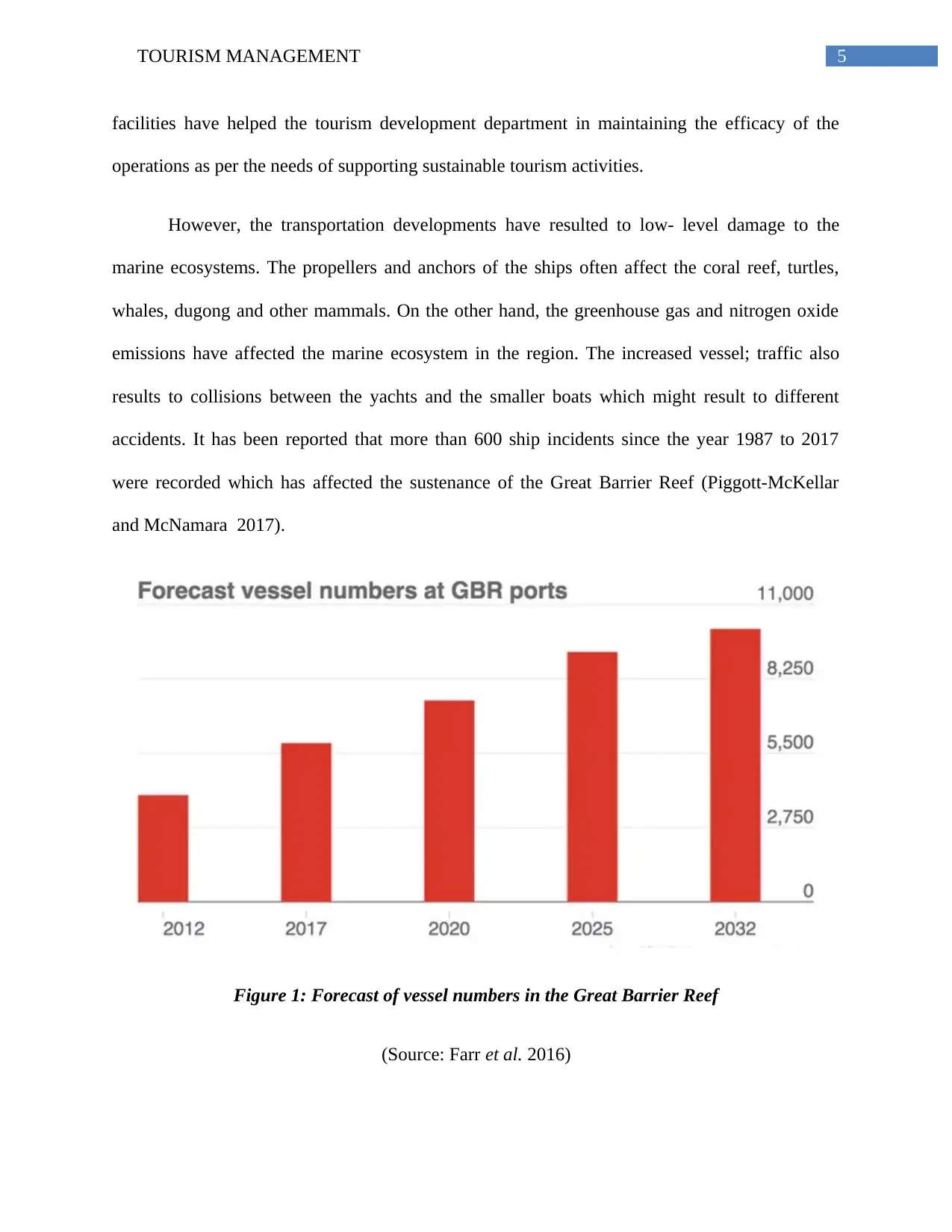
5TOURISM MANAGEMENT
facilities have helped the tourism development department in maintaining the efficacy of the
operations as per the needs of supporting sustainable tourism activities.
However, the transportation developments have resulted to low- level damage to the
marine ecosystems. The propellers and anchors of the ships often affect the coral reef, turtles,
whales, dugong and other mammals. On the other hand, the greenhouse gas and nitrogen oxide
emissions have affected the marine ecosystem in the region. The increased vessel; traffic also
results to collisions between the yachts and the smaller boats which might result to different
accidents. It has been reported that more than 600 ship incidents since the year 1987 to 2017
were recorded which has affected the sustenance of the Great Barrier Reef (Piggott-McKellar
and McNamara 2017).
Figure 1: Forecast of vessel numbers in the Great Barrier Reef
(Source: Farr et al. 2016)
facilities have helped the tourism development department in maintaining the efficacy of the
operations as per the needs of supporting sustainable tourism activities.
However, the transportation developments have resulted to low- level damage to the
marine ecosystems. The propellers and anchors of the ships often affect the coral reef, turtles,
whales, dugong and other mammals. On the other hand, the greenhouse gas and nitrogen oxide
emissions have affected the marine ecosystem in the region. The increased vessel; traffic also
results to collisions between the yachts and the smaller boats which might result to different
accidents. It has been reported that more than 600 ship incidents since the year 1987 to 2017
were recorded which has affected the sustenance of the Great Barrier Reef (Piggott-McKellar
and McNamara 2017).
Figure 1: Forecast of vessel numbers in the Great Barrier Reef
(Source: Farr et al. 2016)
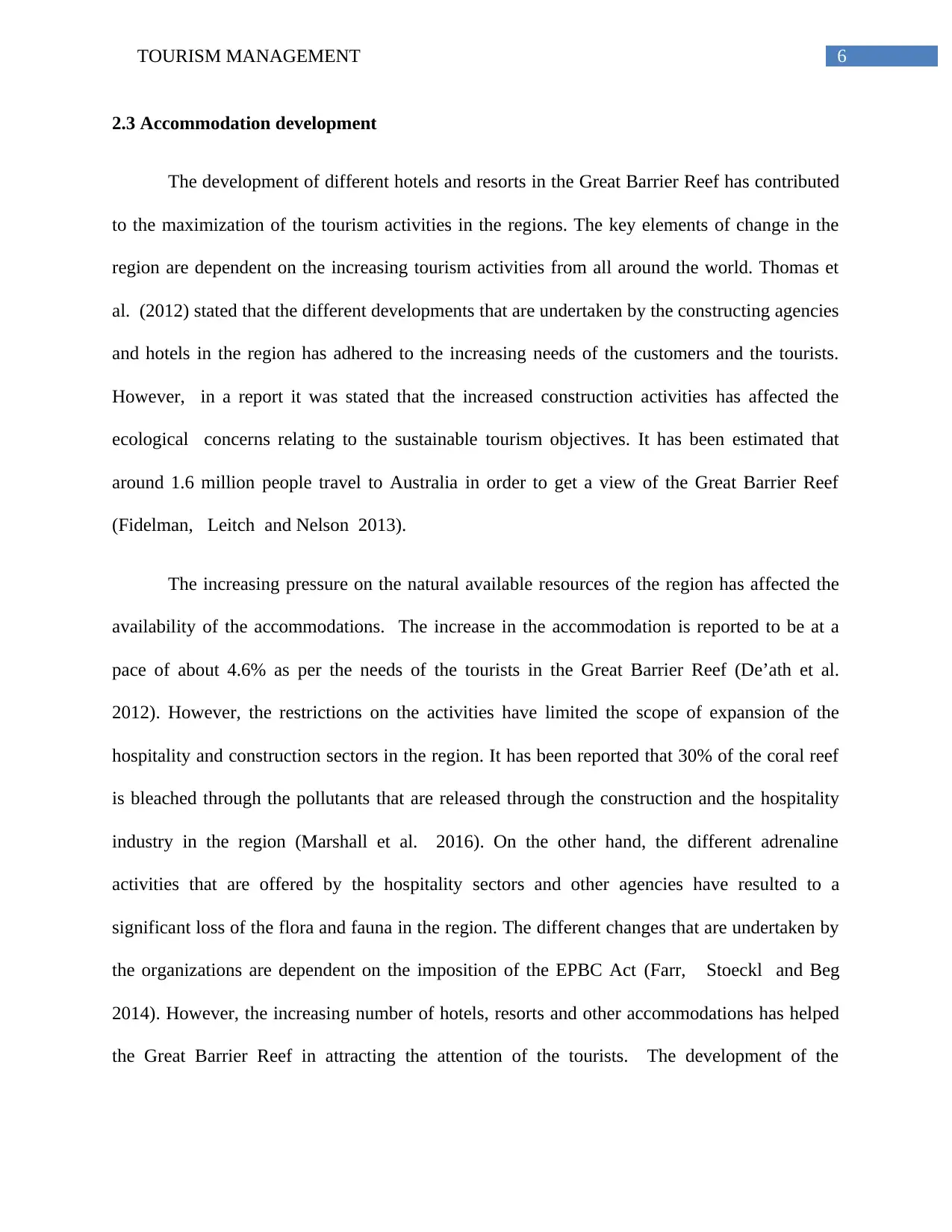
6TOURISM MANAGEMENT
2.3 Accommodation development
The development of different hotels and resorts in the Great Barrier Reef has contributed
to the maximization of the tourism activities in the regions. The key elements of change in the
region are dependent on the increasing tourism activities from all around the world. Thomas et
al. (2012) stated that the different developments that are undertaken by the constructing agencies
and hotels in the region has adhered to the increasing needs of the customers and the tourists.
However, in a report it was stated that the increased construction activities has affected the
ecological concerns relating to the sustainable tourism objectives. It has been estimated that
around 1.6 million people travel to Australia in order to get a view of the Great Barrier Reef
(Fidelman, Leitch and Nelson 2013).
The increasing pressure on the natural available resources of the region has affected the
availability of the accommodations. The increase in the accommodation is reported to be at a
pace of about 4.6% as per the needs of the tourists in the Great Barrier Reef (De’ath et al.
2012). However, the restrictions on the activities have limited the scope of expansion of the
hospitality and construction sectors in the region. It has been reported that 30% of the coral reef
is bleached through the pollutants that are released through the construction and the hospitality
industry in the region (Marshall et al. 2016). On the other hand, the different adrenaline
activities that are offered by the hospitality sectors and other agencies have resulted to a
significant loss of the flora and fauna in the region. The different changes that are undertaken by
the organizations are dependent on the imposition of the EPBC Act (Farr, Stoeckl and Beg
2014). However, the increasing number of hotels, resorts and other accommodations has helped
the Great Barrier Reef in attracting the attention of the tourists. The development of the
2.3 Accommodation development
The development of different hotels and resorts in the Great Barrier Reef has contributed
to the maximization of the tourism activities in the regions. The key elements of change in the
region are dependent on the increasing tourism activities from all around the world. Thomas et
al. (2012) stated that the different developments that are undertaken by the constructing agencies
and hotels in the region has adhered to the increasing needs of the customers and the tourists.
However, in a report it was stated that the increased construction activities has affected the
ecological concerns relating to the sustainable tourism objectives. It has been estimated that
around 1.6 million people travel to Australia in order to get a view of the Great Barrier Reef
(Fidelman, Leitch and Nelson 2013).
The increasing pressure on the natural available resources of the region has affected the
availability of the accommodations. The increase in the accommodation is reported to be at a
pace of about 4.6% as per the needs of the tourists in the Great Barrier Reef (De’ath et al.
2012). However, the restrictions on the activities have limited the scope of expansion of the
hospitality and construction sectors in the region. It has been reported that 30% of the coral reef
is bleached through the pollutants that are released through the construction and the hospitality
industry in the region (Marshall et al. 2016). On the other hand, the different adrenaline
activities that are offered by the hospitality sectors and other agencies have resulted to a
significant loss of the flora and fauna in the region. The different changes that are undertaken by
the organizations are dependent on the imposition of the EPBC Act (Farr, Stoeckl and Beg
2014). However, the increasing number of hotels, resorts and other accommodations has helped
the Great Barrier Reef in attracting the attention of the tourists. The development of the
Paraphrase This Document
Need a fresh take? Get an instant paraphrase of this document with our AI Paraphraser
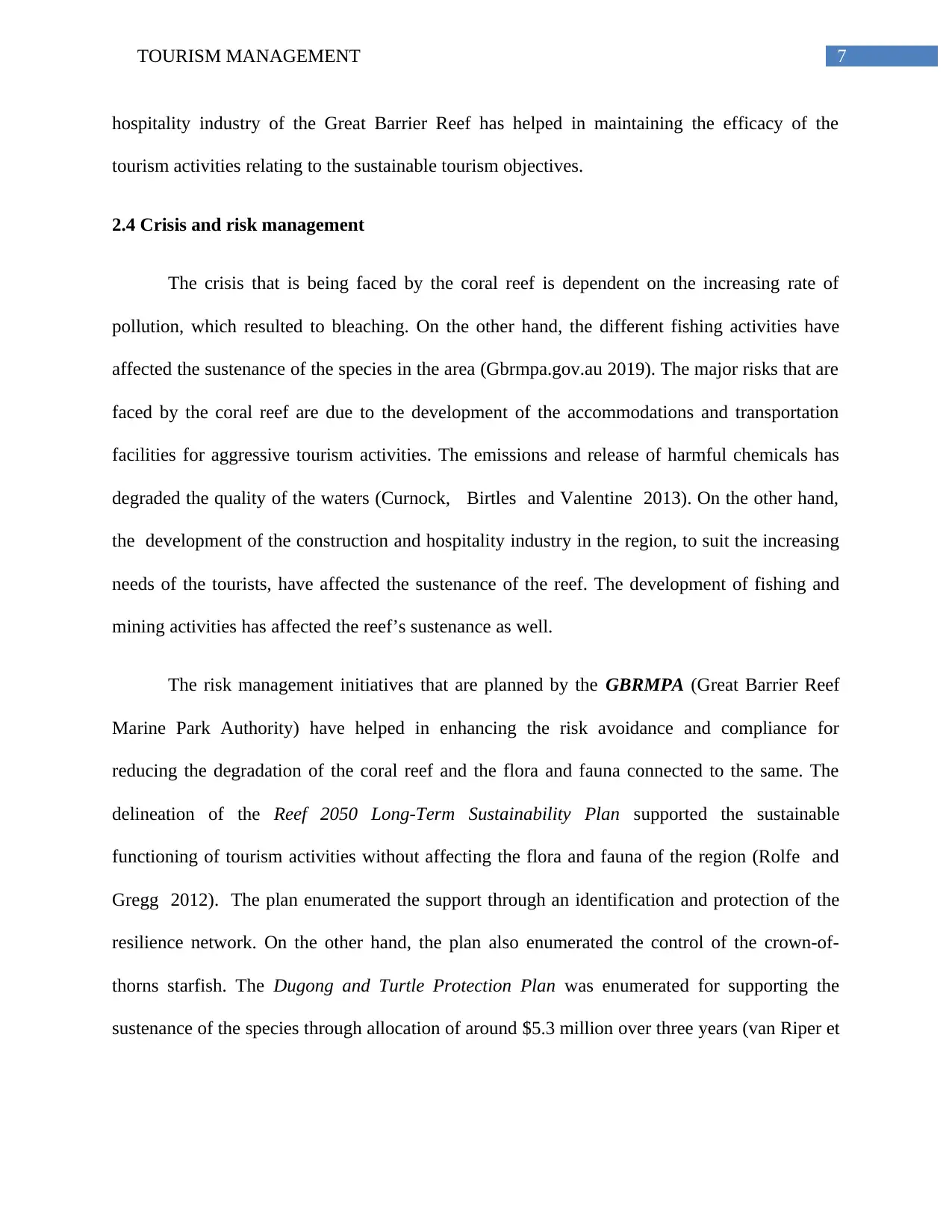
7TOURISM MANAGEMENT
hospitality industry of the Great Barrier Reef has helped in maintaining the efficacy of the
tourism activities relating to the sustainable tourism objectives.
2.4 Crisis and risk management
The crisis that is being faced by the coral reef is dependent on the increasing rate of
pollution, which resulted to bleaching. On the other hand, the different fishing activities have
affected the sustenance of the species in the area (Gbrmpa.gov.au 2019). The major risks that are
faced by the coral reef are due to the development of the accommodations and transportation
facilities for aggressive tourism activities. The emissions and release of harmful chemicals has
degraded the quality of the waters (Curnock, Birtles and Valentine 2013). On the other hand,
the development of the construction and hospitality industry in the region, to suit the increasing
needs of the tourists, have affected the sustenance of the reef. The development of fishing and
mining activities has affected the reef’s sustenance as well.
The risk management initiatives that are planned by the GBRMPA (Great Barrier Reef
Marine Park Authority) have helped in enhancing the risk avoidance and compliance for
reducing the degradation of the coral reef and the flora and fauna connected to the same. The
delineation of the Reef 2050 Long-Term Sustainability Plan supported the sustainable
functioning of tourism activities without affecting the flora and fauna of the region (Rolfe and
Gregg 2012). The plan enumerated the support through an identification and protection of the
resilience network. On the other hand, the plan also enumerated the control of the crown-of-
thorns starfish. The Dugong and Turtle Protection Plan was enumerated for supporting the
sustenance of the species through allocation of around $5.3 million over three years (van Riper et
hospitality industry of the Great Barrier Reef has helped in maintaining the efficacy of the
tourism activities relating to the sustainable tourism objectives.
2.4 Crisis and risk management
The crisis that is being faced by the coral reef is dependent on the increasing rate of
pollution, which resulted to bleaching. On the other hand, the different fishing activities have
affected the sustenance of the species in the area (Gbrmpa.gov.au 2019). The major risks that are
faced by the coral reef are due to the development of the accommodations and transportation
facilities for aggressive tourism activities. The emissions and release of harmful chemicals has
degraded the quality of the waters (Curnock, Birtles and Valentine 2013). On the other hand,
the development of the construction and hospitality industry in the region, to suit the increasing
needs of the tourists, have affected the sustenance of the reef. The development of fishing and
mining activities has affected the reef’s sustenance as well.
The risk management initiatives that are planned by the GBRMPA (Great Barrier Reef
Marine Park Authority) have helped in enhancing the risk avoidance and compliance for
reducing the degradation of the coral reef and the flora and fauna connected to the same. The
delineation of the Reef 2050 Long-Term Sustainability Plan supported the sustainable
functioning of tourism activities without affecting the flora and fauna of the region (Rolfe and
Gregg 2012). The plan enumerated the support through an identification and protection of the
resilience network. On the other hand, the plan also enumerated the control of the crown-of-
thorns starfish. The Dugong and Turtle Protection Plan was enumerated for supporting the
sustenance of the species through allocation of around $5.3 million over three years (van Riper et
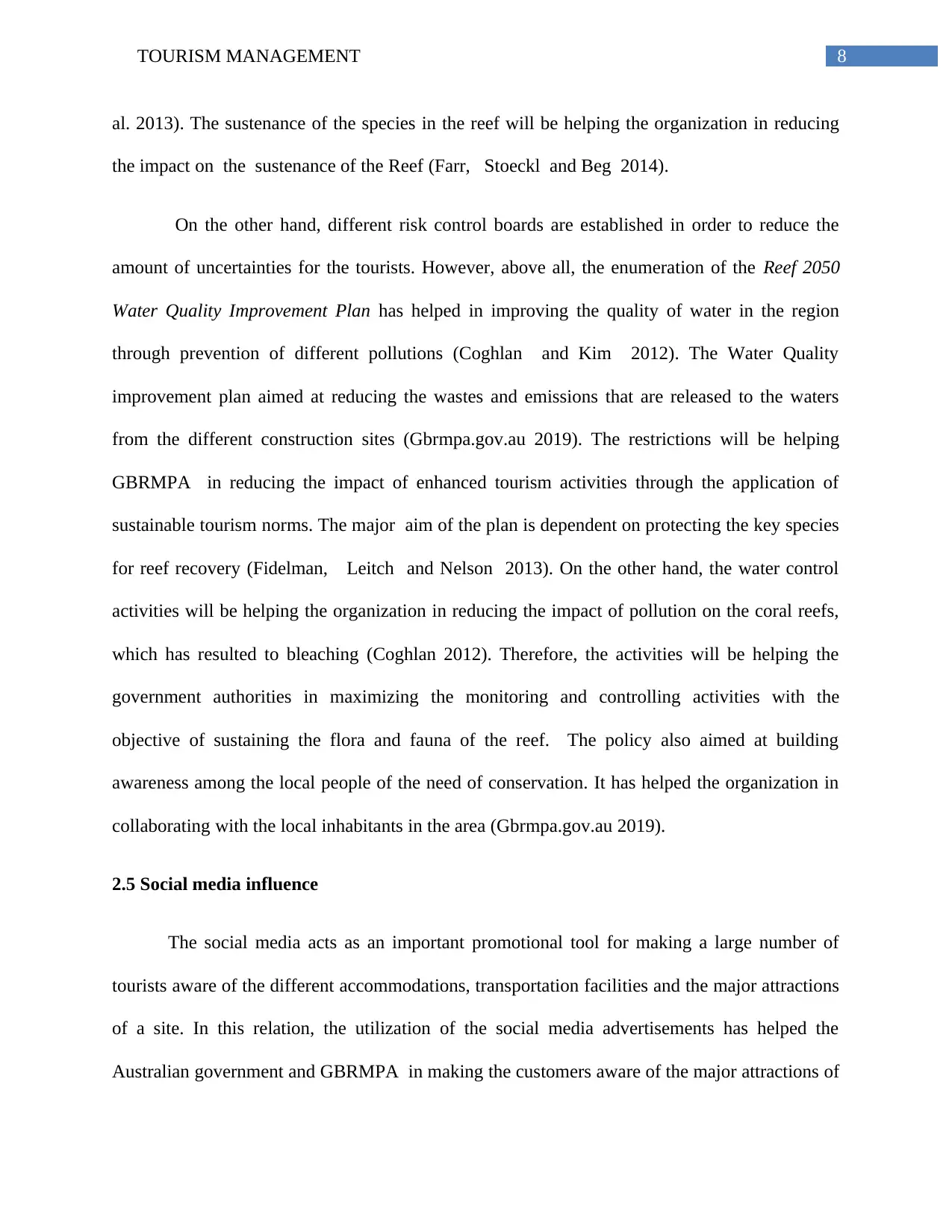
8TOURISM MANAGEMENT
al. 2013). The sustenance of the species in the reef will be helping the organization in reducing
the impact on the sustenance of the Reef (Farr, Stoeckl and Beg 2014).
On the other hand, different risk control boards are established in order to reduce the
amount of uncertainties for the tourists. However, above all, the enumeration of the Reef 2050
Water Quality Improvement Plan has helped in improving the quality of water in the region
through prevention of different pollutions (Coghlan and Kim 2012). The Water Quality
improvement plan aimed at reducing the wastes and emissions that are released to the waters
from the different construction sites (Gbrmpa.gov.au 2019). The restrictions will be helping
GBRMPA in reducing the impact of enhanced tourism activities through the application of
sustainable tourism norms. The major aim of the plan is dependent on protecting the key species
for reef recovery (Fidelman, Leitch and Nelson 2013). On the other hand, the water control
activities will be helping the organization in reducing the impact of pollution on the coral reefs,
which has resulted to bleaching (Coghlan 2012). Therefore, the activities will be helping the
government authorities in maximizing the monitoring and controlling activities with the
objective of sustaining the flora and fauna of the reef. The policy also aimed at building
awareness among the local people of the need of conservation. It has helped the organization in
collaborating with the local inhabitants in the area (Gbrmpa.gov.au 2019).
2.5 Social media influence
The social media acts as an important promotional tool for making a large number of
tourists aware of the different accommodations, transportation facilities and the major attractions
of a site. In this relation, the utilization of the social media advertisements has helped the
Australian government and GBRMPA in making the customers aware of the major attractions of
al. 2013). The sustenance of the species in the reef will be helping the organization in reducing
the impact on the sustenance of the Reef (Farr, Stoeckl and Beg 2014).
On the other hand, different risk control boards are established in order to reduce the
amount of uncertainties for the tourists. However, above all, the enumeration of the Reef 2050
Water Quality Improvement Plan has helped in improving the quality of water in the region
through prevention of different pollutions (Coghlan and Kim 2012). The Water Quality
improvement plan aimed at reducing the wastes and emissions that are released to the waters
from the different construction sites (Gbrmpa.gov.au 2019). The restrictions will be helping
GBRMPA in reducing the impact of enhanced tourism activities through the application of
sustainable tourism norms. The major aim of the plan is dependent on protecting the key species
for reef recovery (Fidelman, Leitch and Nelson 2013). On the other hand, the water control
activities will be helping the organization in reducing the impact of pollution on the coral reefs,
which has resulted to bleaching (Coghlan 2012). Therefore, the activities will be helping the
government authorities in maximizing the monitoring and controlling activities with the
objective of sustaining the flora and fauna of the reef. The policy also aimed at building
awareness among the local people of the need of conservation. It has helped the organization in
collaborating with the local inhabitants in the area (Gbrmpa.gov.au 2019).
2.5 Social media influence
The social media acts as an important promotional tool for making a large number of
tourists aware of the different accommodations, transportation facilities and the major attractions
of a site. In this relation, the utilization of the social media advertisements has helped the
Australian government and GBRMPA in making the customers aware of the major attractions of
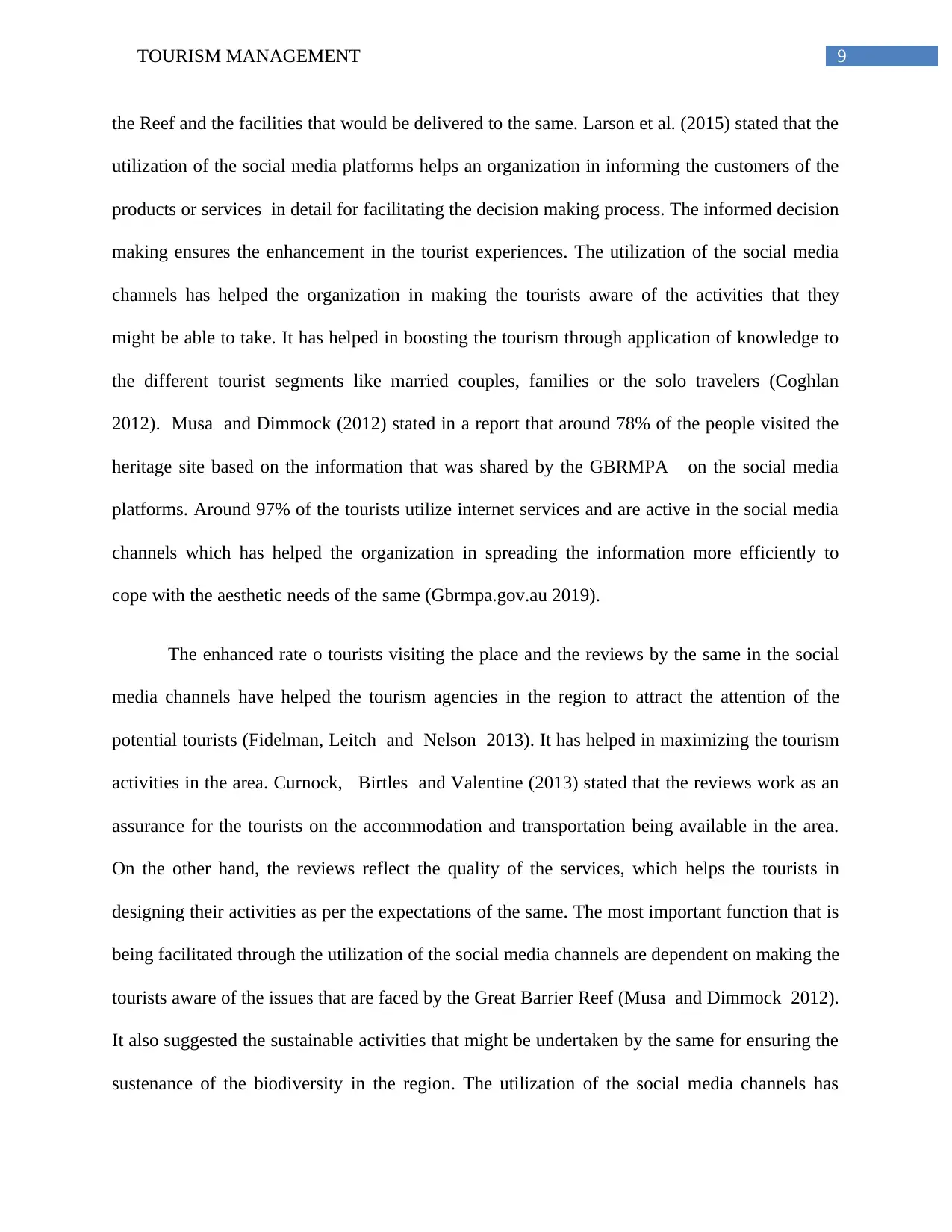
9TOURISM MANAGEMENT
the Reef and the facilities that would be delivered to the same. Larson et al. (2015) stated that the
utilization of the social media platforms helps an organization in informing the customers of the
products or services in detail for facilitating the decision making process. The informed decision
making ensures the enhancement in the tourist experiences. The utilization of the social media
channels has helped the organization in making the tourists aware of the activities that they
might be able to take. It has helped in boosting the tourism through application of knowledge to
the different tourist segments like married couples, families or the solo travelers (Coghlan
2012). Musa and Dimmock (2012) stated in a report that around 78% of the people visited the
heritage site based on the information that was shared by the GBRMPA on the social media
platforms. Around 97% of the tourists utilize internet services and are active in the social media
channels which has helped the organization in spreading the information more efficiently to
cope with the aesthetic needs of the same (Gbrmpa.gov.au 2019).
The enhanced rate o tourists visiting the place and the reviews by the same in the social
media channels have helped the tourism agencies in the region to attract the attention of the
potential tourists (Fidelman, Leitch and Nelson 2013). It has helped in maximizing the tourism
activities in the area. Curnock, Birtles and Valentine (2013) stated that the reviews work as an
assurance for the tourists on the accommodation and transportation being available in the area.
On the other hand, the reviews reflect the quality of the services, which helps the tourists in
designing their activities as per the expectations of the same. The most important function that is
being facilitated through the utilization of the social media channels are dependent on making the
tourists aware of the issues that are faced by the Great Barrier Reef (Musa and Dimmock 2012).
It also suggested the sustainable activities that might be undertaken by the same for ensuring the
sustenance of the biodiversity in the region. The utilization of the social media channels has
the Reef and the facilities that would be delivered to the same. Larson et al. (2015) stated that the
utilization of the social media platforms helps an organization in informing the customers of the
products or services in detail for facilitating the decision making process. The informed decision
making ensures the enhancement in the tourist experiences. The utilization of the social media
channels has helped the organization in making the tourists aware of the activities that they
might be able to take. It has helped in boosting the tourism through application of knowledge to
the different tourist segments like married couples, families or the solo travelers (Coghlan
2012). Musa and Dimmock (2012) stated in a report that around 78% of the people visited the
heritage site based on the information that was shared by the GBRMPA on the social media
platforms. Around 97% of the tourists utilize internet services and are active in the social media
channels which has helped the organization in spreading the information more efficiently to
cope with the aesthetic needs of the same (Gbrmpa.gov.au 2019).
The enhanced rate o tourists visiting the place and the reviews by the same in the social
media channels have helped the tourism agencies in the region to attract the attention of the
potential tourists (Fidelman, Leitch and Nelson 2013). It has helped in maximizing the tourism
activities in the area. Curnock, Birtles and Valentine (2013) stated that the reviews work as an
assurance for the tourists on the accommodation and transportation being available in the area.
On the other hand, the reviews reflect the quality of the services, which helps the tourists in
designing their activities as per the expectations of the same. The most important function that is
being facilitated through the utilization of the social media channels are dependent on making the
tourists aware of the issues that are faced by the Great Barrier Reef (Musa and Dimmock 2012).
It also suggested the sustainable activities that might be undertaken by the same for ensuring the
sustenance of the biodiversity in the region. The utilization of the social media channels has
Secure Best Marks with AI Grader
Need help grading? Try our AI Grader for instant feedback on your assignments.
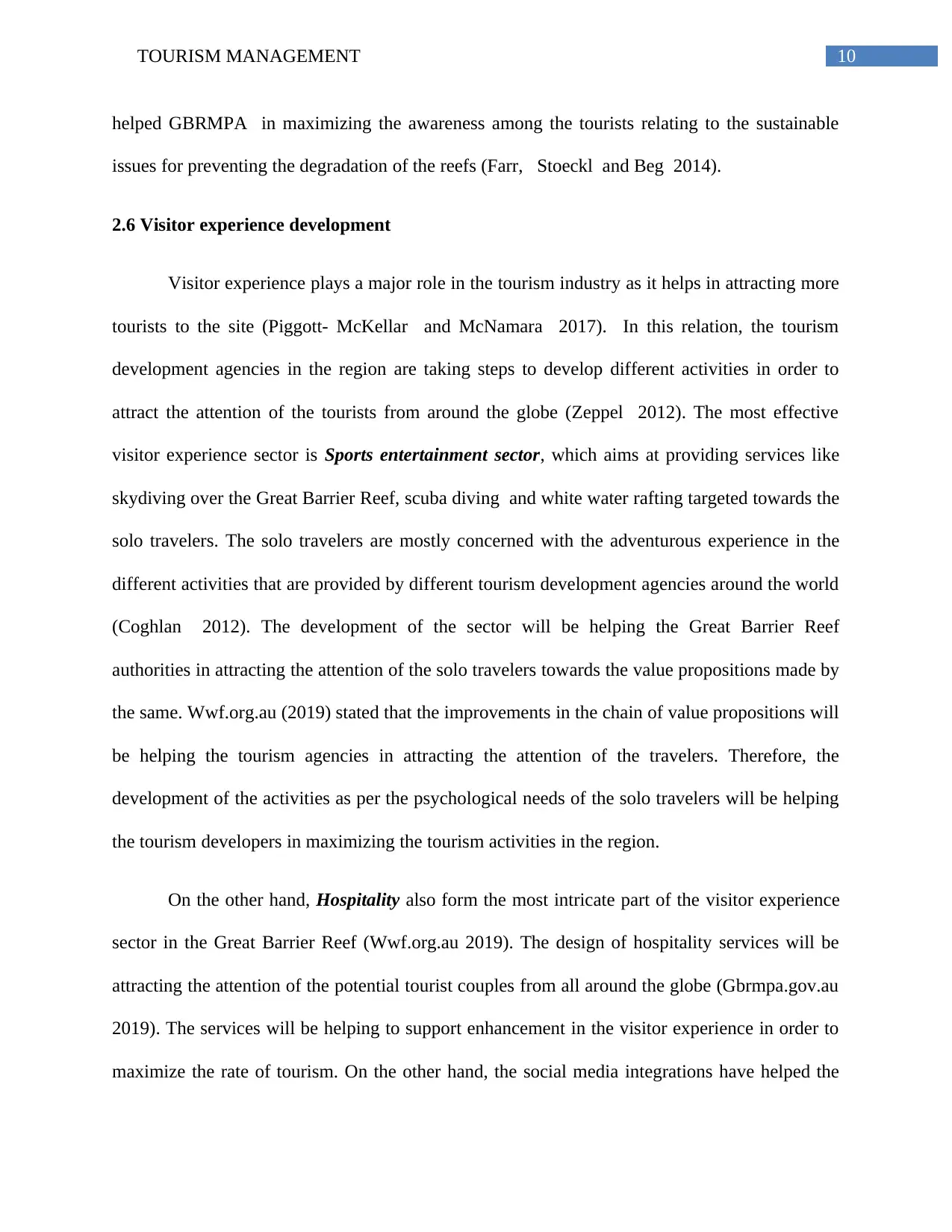
10TOURISM MANAGEMENT
helped GBRMPA in maximizing the awareness among the tourists relating to the sustainable
issues for preventing the degradation of the reefs (Farr, Stoeckl and Beg 2014).
2.6 Visitor experience development
Visitor experience plays a major role in the tourism industry as it helps in attracting more
tourists to the site (Piggott- McKellar and McNamara 2017). In this relation, the tourism
development agencies in the region are taking steps to develop different activities in order to
attract the attention of the tourists from around the globe (Zeppel 2012). The most effective
visitor experience sector is Sports entertainment sector, which aims at providing services like
skydiving over the Great Barrier Reef, scuba diving and white water rafting targeted towards the
solo travelers. The solo travelers are mostly concerned with the adventurous experience in the
different activities that are provided by different tourism development agencies around the world
(Coghlan 2012). The development of the sector will be helping the Great Barrier Reef
authorities in attracting the attention of the solo travelers towards the value propositions made by
the same. Wwf.org.au (2019) stated that the improvements in the chain of value propositions will
be helping the tourism agencies in attracting the attention of the travelers. Therefore, the
development of the activities as per the psychological needs of the solo travelers will be helping
the tourism developers in maximizing the tourism activities in the region.
On the other hand, Hospitality also form the most intricate part of the visitor experience
sector in the Great Barrier Reef (Wwf.org.au 2019). The design of hospitality services will be
attracting the attention of the potential tourist couples from all around the globe (Gbrmpa.gov.au
2019). The services will be helping to support enhancement in the visitor experience in order to
maximize the rate of tourism. On the other hand, the social media integrations have helped the
helped GBRMPA in maximizing the awareness among the tourists relating to the sustainable
issues for preventing the degradation of the reefs (Farr, Stoeckl and Beg 2014).
2.6 Visitor experience development
Visitor experience plays a major role in the tourism industry as it helps in attracting more
tourists to the site (Piggott- McKellar and McNamara 2017). In this relation, the tourism
development agencies in the region are taking steps to develop different activities in order to
attract the attention of the tourists from around the globe (Zeppel 2012). The most effective
visitor experience sector is Sports entertainment sector, which aims at providing services like
skydiving over the Great Barrier Reef, scuba diving and white water rafting targeted towards the
solo travelers. The solo travelers are mostly concerned with the adventurous experience in the
different activities that are provided by different tourism development agencies around the world
(Coghlan 2012). The development of the sector will be helping the Great Barrier Reef
authorities in attracting the attention of the solo travelers towards the value propositions made by
the same. Wwf.org.au (2019) stated that the improvements in the chain of value propositions will
be helping the tourism agencies in attracting the attention of the travelers. Therefore, the
development of the activities as per the psychological needs of the solo travelers will be helping
the tourism developers in maximizing the tourism activities in the region.
On the other hand, Hospitality also form the most intricate part of the visitor experience
sector in the Great Barrier Reef (Wwf.org.au 2019). The design of hospitality services will be
attracting the attention of the potential tourist couples from all around the globe (Gbrmpa.gov.au
2019). The services will be helping to support enhancement in the visitor experience in order to
maximize the rate of tourism. On the other hand, the social media integrations have helped the
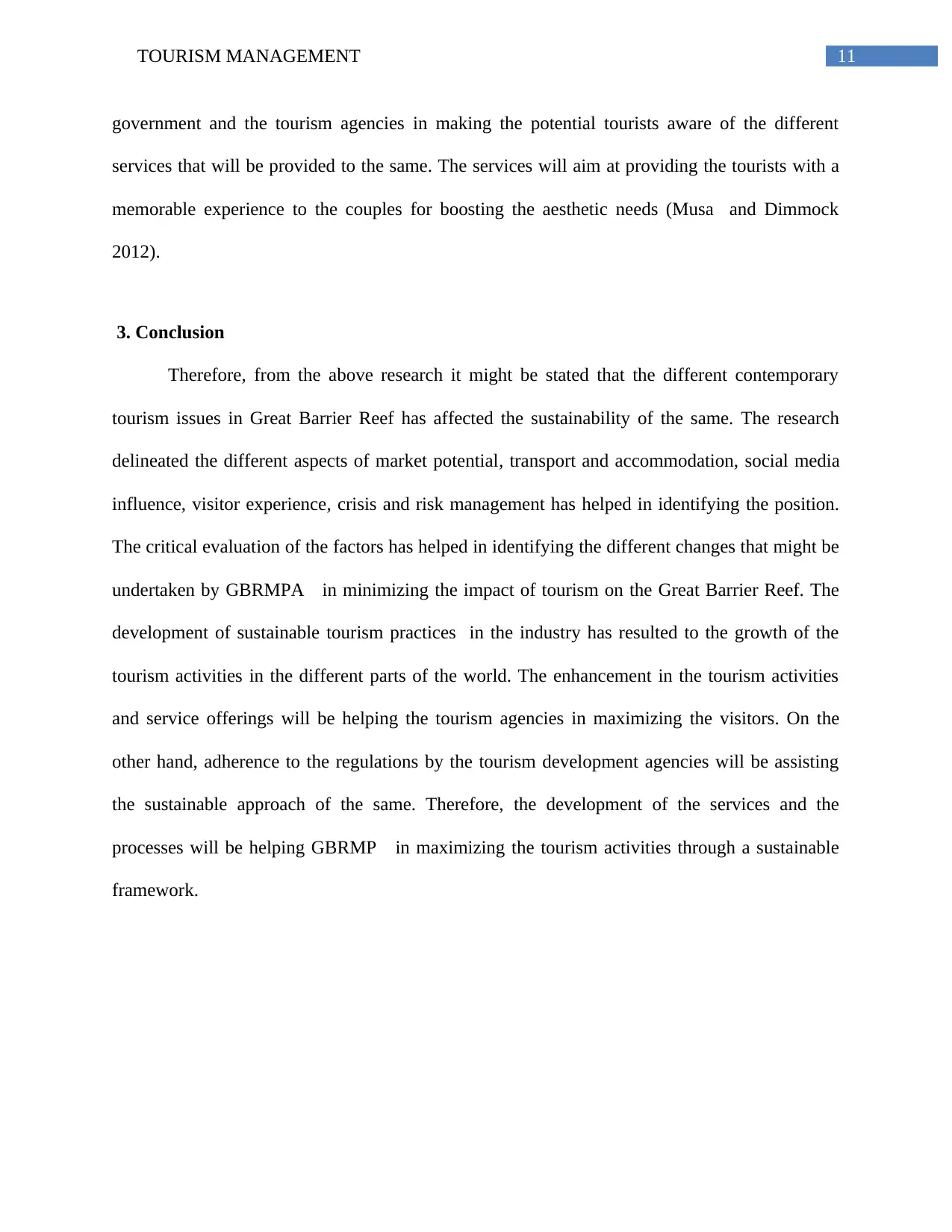
11TOURISM MANAGEMENT
government and the tourism agencies in making the potential tourists aware of the different
services that will be provided to the same. The services will aim at providing the tourists with a
memorable experience to the couples for boosting the aesthetic needs (Musa and Dimmock
2012).
3. Conclusion
Therefore, from the above research it might be stated that the different contemporary
tourism issues in Great Barrier Reef has affected the sustainability of the same. The research
delineated the different aspects of market potential, transport and accommodation, social media
influence, visitor experience, crisis and risk management has helped in identifying the position.
The critical evaluation of the factors has helped in identifying the different changes that might be
undertaken by GBRMPA in minimizing the impact of tourism on the Great Barrier Reef. The
development of sustainable tourism practices in the industry has resulted to the growth of the
tourism activities in the different parts of the world. The enhancement in the tourism activities
and service offerings will be helping the tourism agencies in maximizing the visitors. On the
other hand, adherence to the regulations by the tourism development agencies will be assisting
the sustainable approach of the same. Therefore, the development of the services and the
processes will be helping GBRMP in maximizing the tourism activities through a sustainable
framework.
government and the tourism agencies in making the potential tourists aware of the different
services that will be provided to the same. The services will aim at providing the tourists with a
memorable experience to the couples for boosting the aesthetic needs (Musa and Dimmock
2012).
3. Conclusion
Therefore, from the above research it might be stated that the different contemporary
tourism issues in Great Barrier Reef has affected the sustainability of the same. The research
delineated the different aspects of market potential, transport and accommodation, social media
influence, visitor experience, crisis and risk management has helped in identifying the position.
The critical evaluation of the factors has helped in identifying the different changes that might be
undertaken by GBRMPA in minimizing the impact of tourism on the Great Barrier Reef. The
development of sustainable tourism practices in the industry has resulted to the growth of the
tourism activities in the different parts of the world. The enhancement in the tourism activities
and service offerings will be helping the tourism agencies in maximizing the visitors. On the
other hand, adherence to the regulations by the tourism development agencies will be assisting
the sustainable approach of the same. Therefore, the development of the services and the
processes will be helping GBRMP in maximizing the tourism activities through a sustainable
framework.
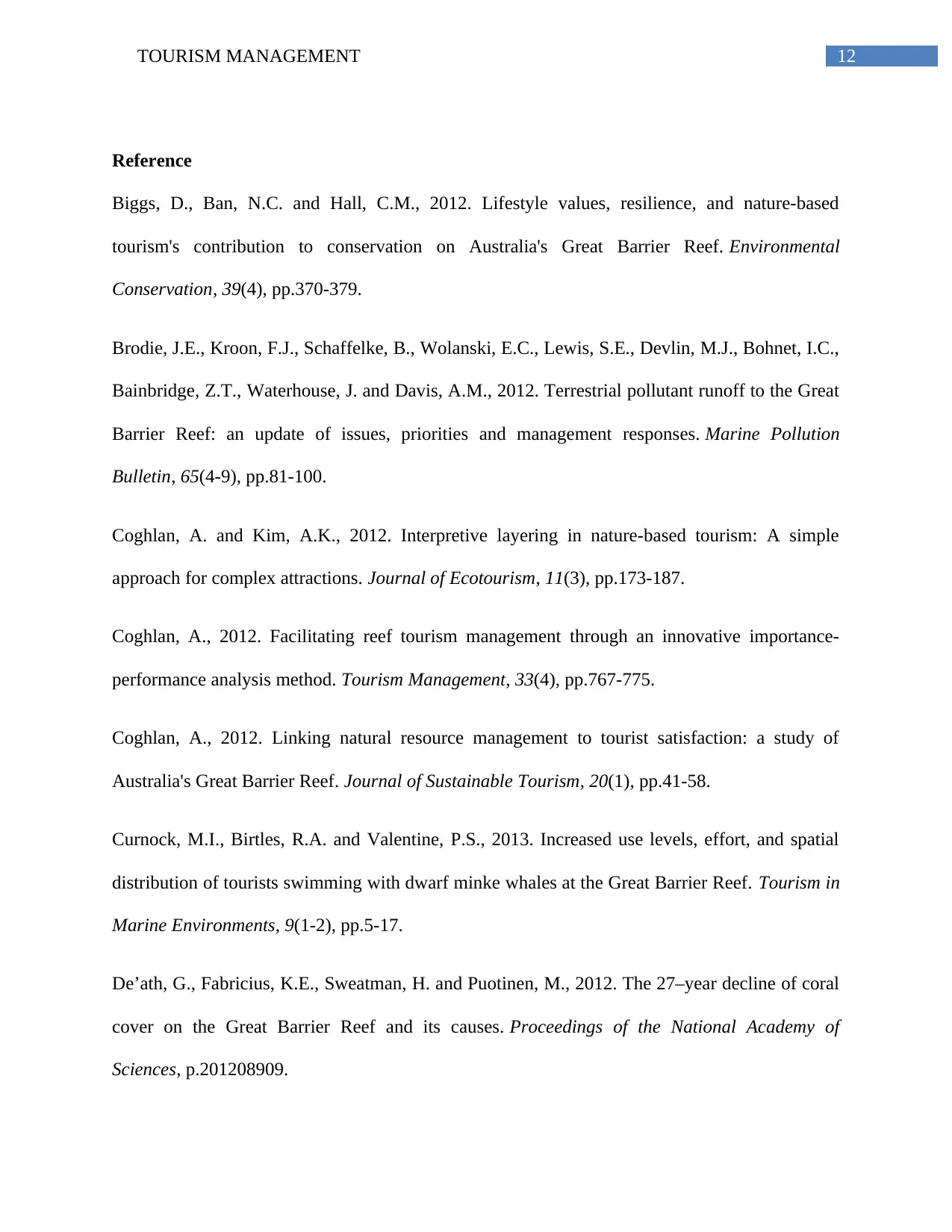
12TOURISM MANAGEMENT
Reference
Biggs, D., Ban, N.C. and Hall, C.M., 2012. Lifestyle values, resilience, and nature-based
tourism's contribution to conservation on Australia's Great Barrier Reef. Environmental
Conservation, 39(4), pp.370-379.
Brodie, J.E., Kroon, F.J., Schaffelke, B., Wolanski, E.C., Lewis, S.E., Devlin, M.J., Bohnet, I.C.,
Bainbridge, Z.T., Waterhouse, J. and Davis, A.M., 2012. Terrestrial pollutant runoff to the Great
Barrier Reef: an update of issues, priorities and management responses. Marine Pollution
Bulletin, 65(4-9), pp.81-100.
Coghlan, A. and Kim, A.K., 2012. Interpretive layering in nature-based tourism: A simple
approach for complex attractions. Journal of Ecotourism, 11(3), pp.173-187.
Coghlan, A., 2012. Facilitating reef tourism management through an innovative importance-
performance analysis method. Tourism Management, 33(4), pp.767-775.
Coghlan, A., 2012. Linking natural resource management to tourist satisfaction: a study of
Australia's Great Barrier Reef. Journal of Sustainable Tourism, 20(1), pp.41-58.
Curnock, M.I., Birtles, R.A. and Valentine, P.S., 2013. Increased use levels, effort, and spatial
distribution of tourists swimming with dwarf minke whales at the Great Barrier Reef. Tourism in
Marine Environments, 9(1-2), pp.5-17.
De’ath, G., Fabricius, K.E., Sweatman, H. and Puotinen, M., 2012. The 27–year decline of coral
cover on the Great Barrier Reef and its causes. Proceedings of the National Academy of
Sciences, p.201208909.
Reference
Biggs, D., Ban, N.C. and Hall, C.M., 2012. Lifestyle values, resilience, and nature-based
tourism's contribution to conservation on Australia's Great Barrier Reef. Environmental
Conservation, 39(4), pp.370-379.
Brodie, J.E., Kroon, F.J., Schaffelke, B., Wolanski, E.C., Lewis, S.E., Devlin, M.J., Bohnet, I.C.,
Bainbridge, Z.T., Waterhouse, J. and Davis, A.M., 2012. Terrestrial pollutant runoff to the Great
Barrier Reef: an update of issues, priorities and management responses. Marine Pollution
Bulletin, 65(4-9), pp.81-100.
Coghlan, A. and Kim, A.K., 2012. Interpretive layering in nature-based tourism: A simple
approach for complex attractions. Journal of Ecotourism, 11(3), pp.173-187.
Coghlan, A., 2012. Facilitating reef tourism management through an innovative importance-
performance analysis method. Tourism Management, 33(4), pp.767-775.
Coghlan, A., 2012. Linking natural resource management to tourist satisfaction: a study of
Australia's Great Barrier Reef. Journal of Sustainable Tourism, 20(1), pp.41-58.
Curnock, M.I., Birtles, R.A. and Valentine, P.S., 2013. Increased use levels, effort, and spatial
distribution of tourists swimming with dwarf minke whales at the Great Barrier Reef. Tourism in
Marine Environments, 9(1-2), pp.5-17.
De’ath, G., Fabricius, K.E., Sweatman, H. and Puotinen, M., 2012. The 27–year decline of coral
cover on the Great Barrier Reef and its causes. Proceedings of the National Academy of
Sciences, p.201208909.
Paraphrase This Document
Need a fresh take? Get an instant paraphrase of this document with our AI Paraphraser
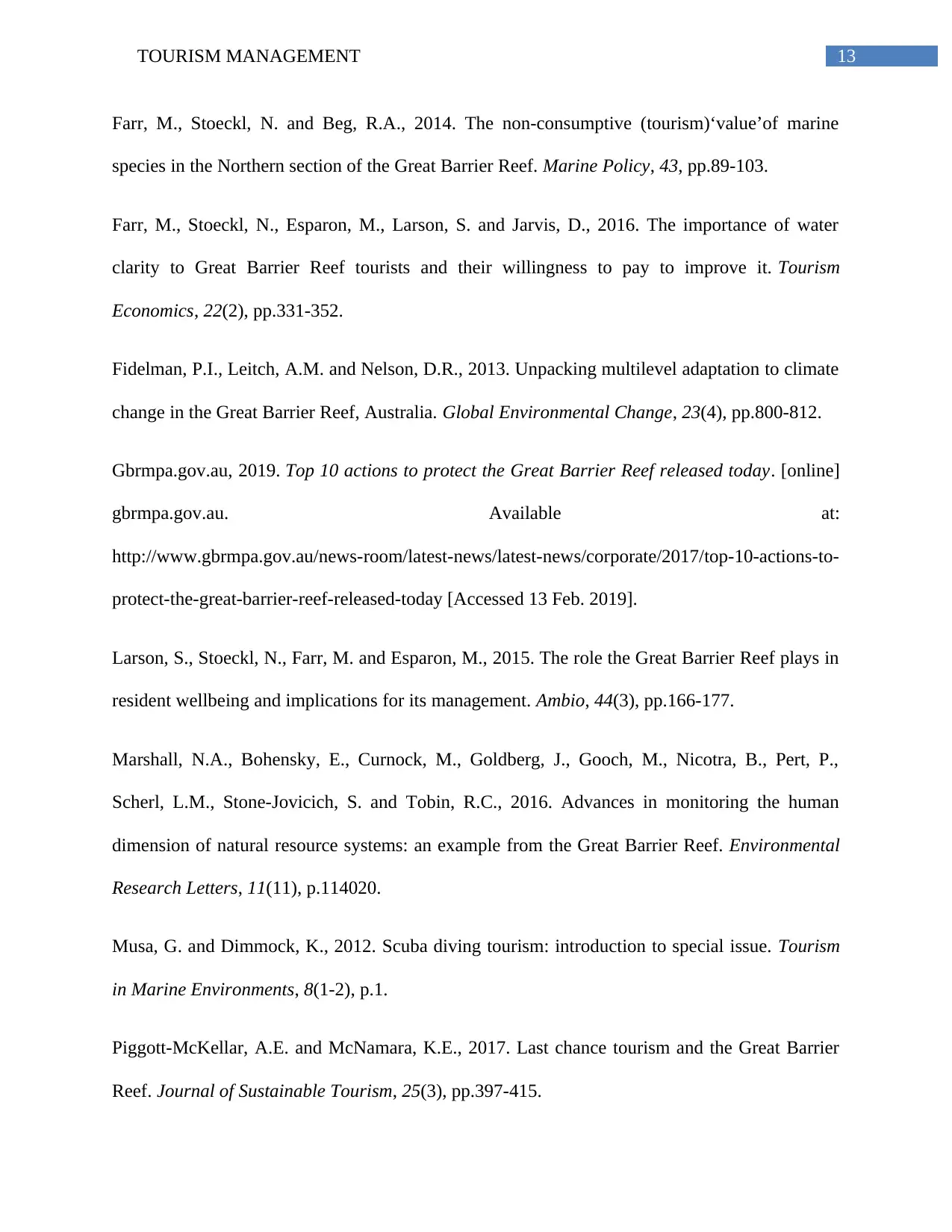
13TOURISM MANAGEMENT
Farr, M., Stoeckl, N. and Beg, R.A., 2014. The non-consumptive (tourism)‘value’of marine
species in the Northern section of the Great Barrier Reef. Marine Policy, 43, pp.89-103.
Farr, M., Stoeckl, N., Esparon, M., Larson, S. and Jarvis, D., 2016. The importance of water
clarity to Great Barrier Reef tourists and their willingness to pay to improve it. Tourism
Economics, 22(2), pp.331-352.
Fidelman, P.I., Leitch, A.M. and Nelson, D.R., 2013. Unpacking multilevel adaptation to climate
change in the Great Barrier Reef, Australia. Global Environmental Change, 23(4), pp.800-812.
Gbrmpa.gov.au, 2019. Top 10 actions to protect the Great Barrier Reef released today. [online]
gbrmpa.gov.au. Available at:
http://www.gbrmpa.gov.au/news-room/latest-news/latest-news/corporate/2017/top-10-actions-to-
protect-the-great-barrier-reef-released-today [Accessed 13 Feb. 2019].
Larson, S., Stoeckl, N., Farr, M. and Esparon, M., 2015. The role the Great Barrier Reef plays in
resident wellbeing and implications for its management. Ambio, 44(3), pp.166-177.
Marshall, N.A., Bohensky, E., Curnock, M., Goldberg, J., Gooch, M., Nicotra, B., Pert, P.,
Scherl, L.M., Stone-Jovicich, S. and Tobin, R.C., 2016. Advances in monitoring the human
dimension of natural resource systems: an example from the Great Barrier Reef. Environmental
Research Letters, 11(11), p.114020.
Musa, G. and Dimmock, K., 2012. Scuba diving tourism: introduction to special issue. Tourism
in Marine Environments, 8(1-2), p.1.
Piggott-McKellar, A.E. and McNamara, K.E., 2017. Last chance tourism and the Great Barrier
Reef. Journal of Sustainable Tourism, 25(3), pp.397-415.
Farr, M., Stoeckl, N. and Beg, R.A., 2014. The non-consumptive (tourism)‘value’of marine
species in the Northern section of the Great Barrier Reef. Marine Policy, 43, pp.89-103.
Farr, M., Stoeckl, N., Esparon, M., Larson, S. and Jarvis, D., 2016. The importance of water
clarity to Great Barrier Reef tourists and their willingness to pay to improve it. Tourism
Economics, 22(2), pp.331-352.
Fidelman, P.I., Leitch, A.M. and Nelson, D.R., 2013. Unpacking multilevel adaptation to climate
change in the Great Barrier Reef, Australia. Global Environmental Change, 23(4), pp.800-812.
Gbrmpa.gov.au, 2019. Top 10 actions to protect the Great Barrier Reef released today. [online]
gbrmpa.gov.au. Available at:
http://www.gbrmpa.gov.au/news-room/latest-news/latest-news/corporate/2017/top-10-actions-to-
protect-the-great-barrier-reef-released-today [Accessed 13 Feb. 2019].
Larson, S., Stoeckl, N., Farr, M. and Esparon, M., 2015. The role the Great Barrier Reef plays in
resident wellbeing and implications for its management. Ambio, 44(3), pp.166-177.
Marshall, N.A., Bohensky, E., Curnock, M., Goldberg, J., Gooch, M., Nicotra, B., Pert, P.,
Scherl, L.M., Stone-Jovicich, S. and Tobin, R.C., 2016. Advances in monitoring the human
dimension of natural resource systems: an example from the Great Barrier Reef. Environmental
Research Letters, 11(11), p.114020.
Musa, G. and Dimmock, K., 2012. Scuba diving tourism: introduction to special issue. Tourism
in Marine Environments, 8(1-2), p.1.
Piggott-McKellar, A.E. and McNamara, K.E., 2017. Last chance tourism and the Great Barrier
Reef. Journal of Sustainable Tourism, 25(3), pp.397-415.
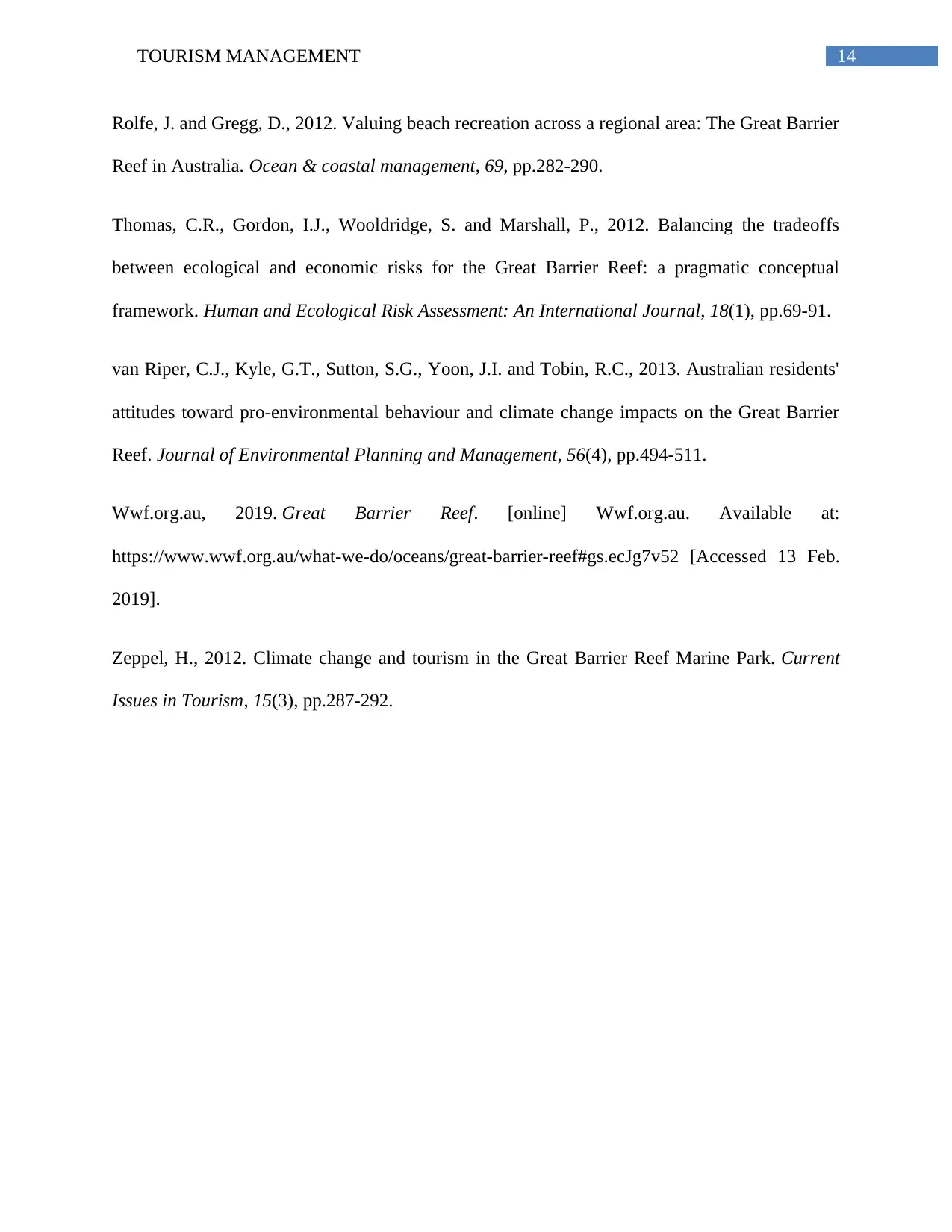
14TOURISM MANAGEMENT
Rolfe, J. and Gregg, D., 2012. Valuing beach recreation across a regional area: The Great Barrier
Reef in Australia. Ocean & coastal management, 69, pp.282-290.
Thomas, C.R., Gordon, I.J., Wooldridge, S. and Marshall, P., 2012. Balancing the tradeoffs
between ecological and economic risks for the Great Barrier Reef: a pragmatic conceptual
framework. Human and Ecological Risk Assessment: An International Journal, 18(1), pp.69-91.
van Riper, C.J., Kyle, G.T., Sutton, S.G., Yoon, J.I. and Tobin, R.C., 2013. Australian residents'
attitudes toward pro-environmental behaviour and climate change impacts on the Great Barrier
Reef. Journal of Environmental Planning and Management, 56(4), pp.494-511.
Wwf.org.au, 2019. Great Barrier Reef. [online] Wwf.org.au. Available at:
https://www.wwf.org.au/what-we-do/oceans/great-barrier-reef#gs.ecJg7v52 [Accessed 13 Feb.
2019].
Zeppel, H., 2012. Climate change and tourism in the Great Barrier Reef Marine Park. Current
Issues in Tourism, 15(3), pp.287-292.
Rolfe, J. and Gregg, D., 2012. Valuing beach recreation across a regional area: The Great Barrier
Reef in Australia. Ocean & coastal management, 69, pp.282-290.
Thomas, C.R., Gordon, I.J., Wooldridge, S. and Marshall, P., 2012. Balancing the tradeoffs
between ecological and economic risks for the Great Barrier Reef: a pragmatic conceptual
framework. Human and Ecological Risk Assessment: An International Journal, 18(1), pp.69-91.
van Riper, C.J., Kyle, G.T., Sutton, S.G., Yoon, J.I. and Tobin, R.C., 2013. Australian residents'
attitudes toward pro-environmental behaviour and climate change impacts on the Great Barrier
Reef. Journal of Environmental Planning and Management, 56(4), pp.494-511.
Wwf.org.au, 2019. Great Barrier Reef. [online] Wwf.org.au. Available at:
https://www.wwf.org.au/what-we-do/oceans/great-barrier-reef#gs.ecJg7v52 [Accessed 13 Feb.
2019].
Zeppel, H., 2012. Climate change and tourism in the Great Barrier Reef Marine Park. Current
Issues in Tourism, 15(3), pp.287-292.
1 out of 15
Related Documents
Your All-in-One AI-Powered Toolkit for Academic Success.
+13062052269
info@desklib.com
Available 24*7 on WhatsApp / Email
![[object Object]](/_next/static/media/star-bottom.7253800d.svg)
Unlock your academic potential
© 2024 | Zucol Services PVT LTD | All rights reserved.





